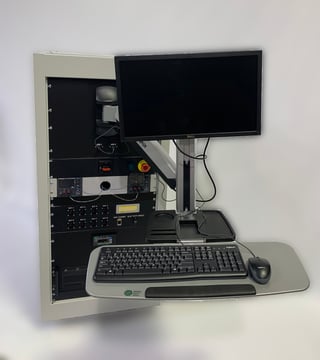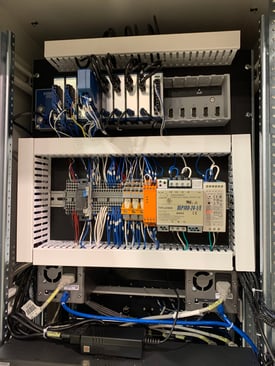+1 (317) 804-2330 | info@ballsystems.com | Blog
+1 (317) 804-2330 | info@ballsystems.com | Blog
 The BLEAM DAQ Cart Design Validation Tester is an automated measurement/control system designed to interface with a motorized actuation fixture that accommodates various PCAs (DUTs) in a thermal chamber. The door-lock controller PCA (DUT) includes the following electrical/data interfaces: BLE (Bluetooth Low Energy), LIN (Local Interconnect Network), S.O.P (Signal Over Power).
The BLEAM DAQ Cart Design Validation Tester is an automated measurement/control system designed to interface with a motorized actuation fixture that accommodates various PCAs (DUTs) in a thermal chamber. The door-lock controller PCA (DUT) includes the following electrical/data interfaces: BLE (Bluetooth Low Energy), LIN (Local Interconnect Network), S.O.P (Signal Over Power).
The customer is a Tier-1 automotive supplier building “automotive door-lock actuation controller PCAs” (typically mounted within a car door handle) which can be proximity actuated (with a finger) or near-field actuated through a “Bluetooth Low Energy Actuation Method” from a cellphone or key-fob. Their need is to validate the design robustness of the door-lock controller for OEM usage.
The most challenging technical problem solved in this system was collecting data reliably from the S.O.P. DUT interface. The solution required appropriate electrical S.O.P interface signal conditioning and capture/storage of all data packet signal transitions by the measurement system prior to measuring signal pulse widths. In other words, the S.O.P data was captured in real-time, then pulse-width measurements occurred later in the background in software.
In operation, the tester controls the actuation fixture, electrically powers and interfaces to the attached DUTs, and controls the thermal chamber temperature via programmed temperature cycles (up and down in short time intervals). While cycling, the tester measures DUT actuation/switching performance and logs that pulse timing data.

The LabView application software in the test system is designed as a recipe-based application so that the customer can run different actuation speeds using variable fixture speeds and chamber temperature profiles during DUT performance validation runs.
Data is collected and stored locally, then transmitted to the customer’s corporate SQL database at selectable intervals. DUT design validation is proven through repeated successful DUT actuations (within programmable limits) over extended periods of time and repeated temperature cycles.
Our automotive customer was pleased with tester performance and project timing. All tester requirements were met and requested features provided during the project execution.
Ball Systems designs, develops, and delivers custom test systems and produces comprehensive build-to-print systems for companies creating or manufacturing critical electronic or electro-mechanical components for automotive, aerospace and defense and consumer appliance applications.